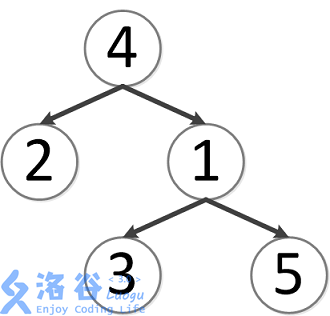AC日记——【模板】最近公共祖先(LCA)洛谷 P3379
题目描述
如题,给定一棵有根多叉树,请求出指定两个点直接最近的公共祖先。
输入输出格式
输入格式:
第一行包含三个正整数N、M、S,分别表示树的结点个数、询问的个数和树根结点的序号。
接下来N-1行每行包含两个正整数x、y,表示x结点和y结点之间有一条直接连接的边(数据保证可以构成树)。
接下来M行每行包含两个正整数a、b,表示询问a结点和b结点的最近公共祖先。
输出格式:
输出包含M行,每行包含一个正整数,依次为每一个询问的结果。
输入输出样例
输入样例#1:
5 5 4 3 1 2 4 5 1 1 4 2 4 3 2 3 5 1 2 4 5
输出样例#1:
4 4 1 4 4
说明
时空限制:1000ms,128M
数据规模:
对于30%的数据:N<=10,M<=10
对于70%的数据:N<=10000,M<=10000
对于100%的数据:N<=500000,M<=500000
样例说明:
该树结构如下:

第一次询问:2、4的最近公共祖先,故为4。
第二次询问:3、2的最近公共祖先,故为4。
第三次询问:3、5的最近公共祖先,故为1。
第四次询问:1、2的最近公共祖先,故为4。
第五次询问:4、5的最近公共祖先,故为4。
故输出依次为4、4、1、4、4。
思路:
树剖。
来,上代码:
#include <cstdio> #include <iostream> #include <algorithm> #define maxn 500001 using namespace std; struct EdgeType { int to,next; }; struct EdgeType edge[maxn<<1]; int if_z,n,m,s,num,f[maxn],deep[maxn]; int belong[maxn],size[maxn],cnt,head[maxn]; char Cget; inline void read_int(int &now) { now=0,if_z=1,Cget=getchar(); while(Cget>'9'||Cget<'0') { if(Cget=='-') if_z=-1; Cget=getchar(); } while(Cget>='0'&&Cget<='9') { now=now*10+Cget-'0'; Cget=getchar(); } now*=if_z; } inline void edge_add(int from,int to) { edge[++num].to=from,edge[num].next=head[to],head[to]=num; edge[++num].to=to,edge[num].next=head[from],head[from]=num; } void search(int now,int fa) { int pos=cnt++; f[now]=fa,deep[now]=deep[fa]+1; for(int i=head[now];i;i=edge[i].next) { if(edge[i].to==fa) continue; search(edge[i].to,now); } size[now]=cnt-pos; } void search_(int now,int chain) { int pos=0; belong[now]=chain; for(int i=head[now];i;i=edge[i].next) { if(edge[i].to==f[now]) continue; if(size[pos]<size[edge[i].to]) pos=edge[i].to; } if(pos!=0) search_(pos,chain); else return ; for(int i=head[now];i;i=edge[i].next) { if(edge[i].to==pos||edge[i].to==f[now]) continue; search_(edge[i].to,edge[i].to); } } inline int lca(int x,int y) { while(belong[x]!=belong[y]) { if(deep[belong[x]]<deep[belong[y]]) swap(x,y); x=f[belong[x]]; } if(deep[x]<deep[y]) return x; else return y; } int main() { read_int(n),read_int(m),read_int(s); int from,to; for(int i=1;i<n;i++) { read_int(from),read_int(to); edge_add(from,to); } search(s,0),cnt=0,search_(s,s); for(int i=1;i<=m;i++) { read_int(from),read_int(to); printf("%d\n",lca(from,to)); } return 0; }
附,70分暴力找lca:

#include <cstdio> #include <algorithm> #define maxn 500001 using namespace std; struct EdgeType { int to,next; }; struct EdgeType edge[maxn<<1]; int f[maxn],head[maxn],num; int n,m,s,if_z,dfn[maxn],cnt; char Cget; inline void read_int(int &now) { now=0,if_z=1,Cget=getchar(); while(Cget>'9'||Cget<'0') { if(Cget=='-') if_z=-1; Cget=getchar(); } while(Cget>='0'&&Cget<='9') { now=now*10+Cget-'0'; Cget=getchar(); } now*=if_z; } inline void edge_add(int from,int to) { edge[++num].to=from,edge[num].next=head[to],head[to]=num; edge[++num].to=to,edge[num].next=head[from],head[from]=num; } void search(int now,int fa) { dfn[now]=++cnt,f[now]=fa; for(int i=head[now];i;i=edge[i].next) { if(edge[i].to==fa) continue; search(edge[i].to,now); } } inline int lca(int x,int y) { if(dfn[x]<dfn[y]) swap(x,y); while(dfn[x]>dfn[y]) x=f[x]; while(dfn[y]>dfn[x]) y=f[y]; return y; } int main() { read_int(n),read_int(m),read_int(s); int from,to; for(int i=1;i<n;i++) { read_int(from),read_int(to); edge_add(from,to); } search(s,0); for(int i=1;i<=m;i++) { read_int(from),read_int(to); printf("%d\n",lca(from,to)); } return 0; }



 浙公网安备 33010602011771号
浙公网安备 33010602011771号